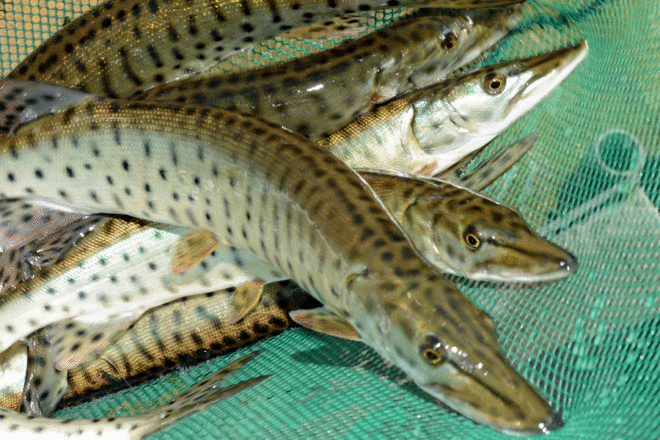DNR Trying to Re-establish Spotted Musky
- Share
- Tweet
- Pin
- Share

Efforts to establish a self-sustaining population of spotted musky in Wisconsin’s Lake Michigan waters got a boost this fall when 7,000 musky fingerling averaging 17 inches were stocked into the Fox River, several Green Bay tributaries, Lake Winnebago and three inland lakes.
The fingerlings were raised for a year in cool water ponds at Wild Rose State Fish Hatchery. They now weigh about a pound and average 17 inches in length, although some were pushing 19 and 20 inches.
Department of Natural Resources fish crew members stocked roughly 1,350 fish into the future broodstock lakes of Anderson and Archibald Lakes in Oconto County and Elkhart Lake in Sheboygan County, according to Jesse Landwehr, hatchery supervisor. The three inland lakes will serve as the source of brood stock in future years. Beginning in 2019, DNR tentatively will spawn spotted muskies in an effort to ramp up production in the hatcheries.
Historically, spotted musky were native to Lake Michigan and its tributaries in Wisconsin but habitat destruction, pollution and over-exploitation during the early to mid-1900s decimated their populations. DNR in cooperation with several local musky clubs and the Musky Clubs Alliance of Wisconsin started to reintroduce the Great Lakes strain musky into Green Bay waters of Lake Michigan in 1989.
They stocked fish that were hatched from eggs collected from Michigan waters where spotted musky still are found, and raised them at Wild Rose State Fish Hatchery. Those stockings have helped create a popular fishery in Green Bay with anglers reeling in many 50-plus-inch fish but the ultimate goal of the project – creating a self-sustaining population – has been elusive.
DNR staff have worked in recent years to diversify the genetic pool in hopes of seeing better natural reproduction. Michigan had been providing 5- to 6-inch fingerlings to Wisconsin hatched from disinfected eggs and Wisconsin has been sending northern Wisconsin musky fingerlings to Michigan in return. Creating broodstock lakes will enable Wisconsin to spawn its own fish.
All the fish going into the three brood lakes were fin-clipped and PIT tagged so DNR can identify individual fish and their parentage. “This enables us when we are spawning on the brood stock lakes in the future to maintain genetic diversity,” Landwehr said.
For the rest of the fish going into the Green Bay system, 20 percent were tagged and clipped to help local biologists identify individual fish and assess their growth rates.

